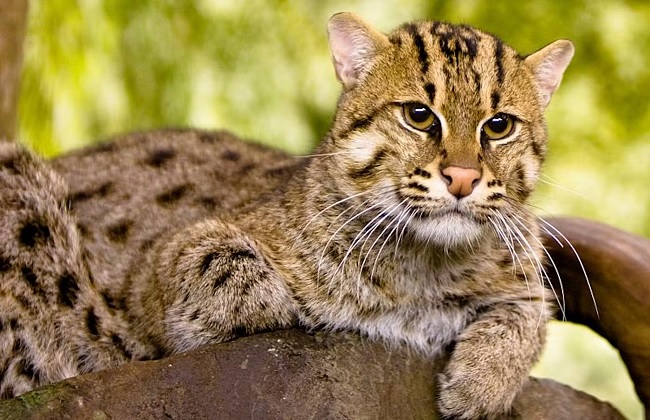
In a quiet village called Charghikamala in Rajbari district, a sad story unfolded one night. Helal, a villager, heard his goat crying out in fear. When he went to check, he found a beautiful creature lying still under the moonlight — a fishing cat, with fur like twilight and eyes shining like emeralds.
Helal says he felt sad seeing the cat. This wasn’t just any cat; it was a guardian of the wetlands. Unfortunately, its life ended in the blink of an eye. News of the killed cat spread fast, turning villagers both curious and fearful.
Helal told everyone what had happened. He had heard his goat crying, saw something moving in the dark in the goat’s vicinity, and in his panic, he swung his machete. It was all a big misunderstanding, he said. The cat was just looking for food, but it ended up dead because Helal couldn’t understand it.
This isn’t isolated incident. It’s part of a bigger problem in Bangladesh’s wetlands. As villages grow, the cats’ homes disappear, and they end up closer to human habitation in search of food.
A recent survey by Dhaka University’s Zoology Department paints a grim picture of Bangladesh’s lesser-known fishing cats (Prionailurus viverrinus). The study reveals a worrying frequency of conflicts between humans and these elusive creatures: every two weeks, on average.
Between 2016 and 2021, a staggering 361 cases involving fishing cats have been documented nationwide. This translates to a new conflict arising every fortnight, highlighting the rapid decline of an already vulnerable species. In total, the reports comprise 160 fishing cat deaths.
“These conflicts are more than just statistics,” explains Muntasir Akash, a DU zoology academic who led the survey. “They signal the breakdown of a fragile ecosystem.”
He attributes most conflicts to the dry season, when shrinking water sources leave fishing cats struggling to find food. Habitat loss due to the conversion of wetlands into cities, farms and fishponds further pushes them toward danger zones.
“It is further fueled by general intolerance toward fishing cats and any other wildlife,” Akash says, highlighting that nearly 50% of reported incidents were triggered as retaliation-on-sight reactions rather than any actual harm done by the cats.
Despite being recorded in Bangladesh, Cambodia, India, Myanmar, Nepal, Pakistan, Sri Lanka and Thailand, the exact global range of the fishing cat remains unclear due to unreliable data. Their patchy distribution across South and Southeast Asia likely reflects their dependence on scarce and scattered wetlands in the region, according to the nonprofit Small Cat Advocacy and Research.
IUCN classified Bangladesh’s fishing cats as endangered in 2015. Despite being widespread, these cats face high conflict rates in every wetland stronghold. More than 90% of their habitat receives no conservation efforts, according to researchers.
What is fueling the fire?
In Bangladesh, much focus has been on protecting large carnivores causing significant damage, while the killings of smaller ones have largely been overlooked. Recently, researchers have delved into the puzzling phenomenon of why locals in northeastern Bangladesh were targeting fishing cats.
The study has revealed a disconcerting pattern: Groups of 10–15 people, motivated by fear, were employing various tools to kill these felines without any intention to sell their carcasses.
“Unlike other carnivores, fear, not financial gain, motivated these killings,” the study says.
Jahangirnagar University’s Department of Zoology Professor M.A. Aziz, who also co-authored the study, emphasizes two key factors driving the indiscriminate killing of fishing cats by humans: people’s perception and social obligation.
“Locals often mistake fishing cats for tigers due to their similar appearance and limited awareness within the community,” Aziz explains. “This fear leads to the belief that these cats pose a physical threat, prompting people to kill them.”
“Furthermore, societal pressure plays a significant role,” he notes. “Individuals feel compelled to participate in such killings due to social norms and values.”
He also highlights the desire for revenge as another motivation. Interestingly, despite fishing cats being blamed, it’s actually jackals (Canis aureus) and jungle cats (Felis chaus) that cause most damage to poultry farms.
“In our study area, many fishing cats were killed by poultry farmers,” he notes. “They use traps baited with chickens to catch and kill the cats almost every night in retaliation for losses in their poultry farms.”
“Moreover, many of these farms are illegally occupying government lands,” he adds, “taking advantage of their proximity to wetlands to raise ducks conveniently.”
Akash highlights one of the latest plights of fishing cats in Bangladesh: Ongoing infrastructure development projects often overlook environmental concerns. “The construction of the Dhaka-Mawa expressway, for example, severely impacted the fishing cat population in Arial Beel, the country’s third-largest freshwater wetland. We observed a significant rise in cat deaths after the highway opened, likely due to them attempting to cross the road.”
He emphasizes the vital role that fishing cats play in maintaining healthy wetlands. “They are the ambassadors of healthy wetlands,” he says. “Their decline will surely spiral into a cascading effect that will ultimately impact people who rely on healthy wetlands for fishing and agriculture. Bangladesh desperately needs a countrywide conservation program for fishing cats before it is too little too late.”
Mirza Mehedhi Sorowar, a wildlife and biodiversity conservation officer with the Department of Forest, however, highlights the positive impact of the government’s awareness campaigns on protecting the country’s wildlife.
He notes, “There was a time when incidents of fishing cat killings went unreported in the media. Nowadays, aided by easy communication modes, villagers promptly notify us whenever a fishing cat is spotted in their locality.”
Sorowar emphasizes that the reduction of wetlands and the decline of indigenous fish in natural water bodies pose significant challenges for the cats. He urges individuals, organizations and the media to collaborate in raising awareness and addressing these issues.
A glimmer of hope
In a challenging scenario, there’s still hope. Hardworking conservationists are studying conflicts and finding solutions. Meet Project Fishing Cat Bangladesh, founded in 2012, which engages in conservation efforts Baikka Beel in northeast Bangladesh’s Hail Haor Wildlife Sanctuary.
The project aims to educate locals on the importance of fishing cats, mitigate conflicts and safeguard the species for the future. They implement innovative solutions such as predator-proof enclosures to reduce human-fishing cat conflicts.
“Despite limited resources, our Baikka Beel project is making headway. Locals are increasingly aware of fishing cats’ importance,” says project leader Sayam U Chowdhury.
“Large-scale government awareness campaigns reaching the grassroots level are crucial,” Chowdhury emphasizes. “People need to understand that fishing cats pose no threat.”
He further urges the government to consider implementing environmentally friendly agricultural practices to ensure the long-term well-being of wildlife.
Another project with Aziz to tackle human-cat conflict started in 2017 targets zones in Hakaluki Haor. It explores vegetation structures to create better fishing cat habitat and reduce killings. Beyond exploring integrated habitat restoration with flood management schemes, the project tackles social norms that tolerate fishing cat killings.
They aim to elevate the value of these cats through primary school education and further surveys to develop meaningful solutions. Local communities and students are joining the effort.
“Despite housing the majority of the world’s fishing cats, Bangladesh lacks significant government initiatives for their protection. We must act now to prevent these magnificent creatures from vanishing from our nation,” Aziz warns.
(This article was republished from Mongabay under Creative Commons License)
Mahadi Al Hasnat is a freelance writer specializing in environmental journalism and a communication professional.


